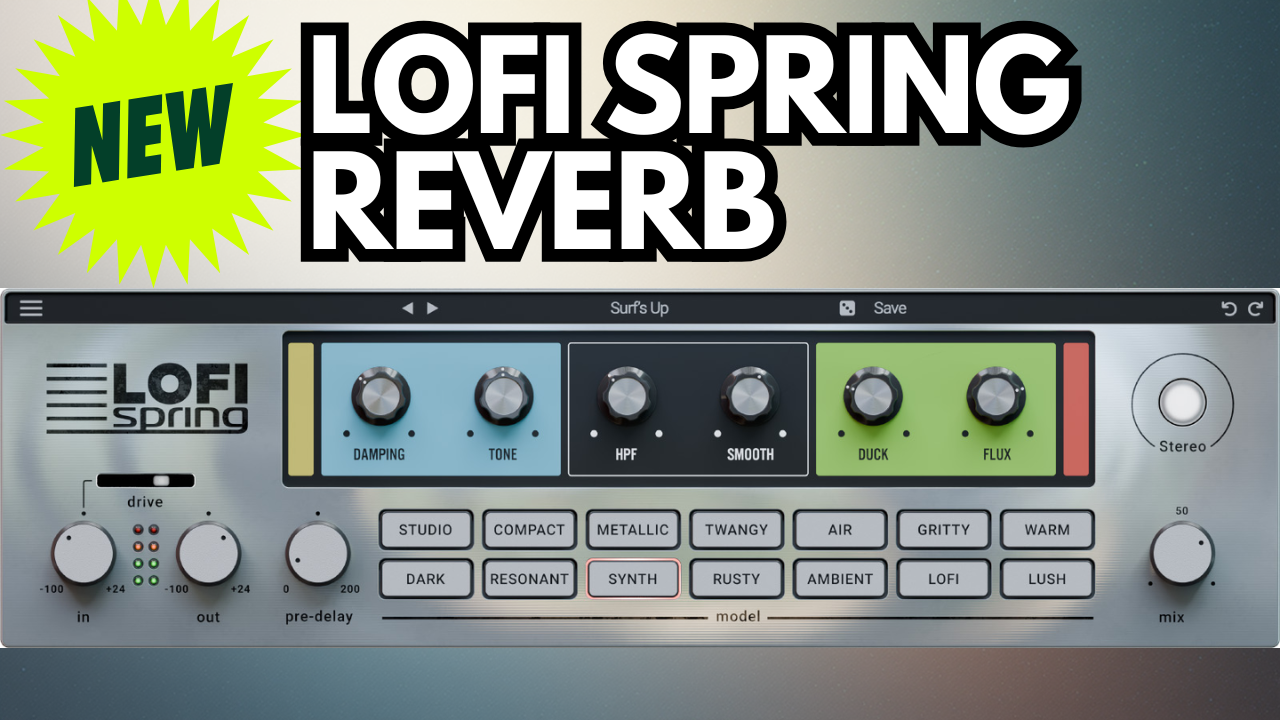As a producer always hunting for that elusive analog warmth in digital workflows, I stumbled upon LoFi Springs from Wave Alchemy and knew I had to dive deep. This isn’t just another reverb plugin—it’s a soulful time machine that captures the raw, imperfect magic of vintage spring reverbs, blending them with modern creative tools. Whether you’re crafting lo-fi beats, indie tracks, or electronic soundscapes, LoFi Springs delivers everything from smooth retro tails to gloriously decayed chaos. In this review, I’ll break down its standout features, share audio demos from my session, and explain why it’s become a staple in my DAW.
Related Posts:
- Blockchain Ultra Review – 87 FX Modules That Will Transform Your Music Production
- Lofinity Review: The Ultimate One-Knob Lo-Fi Plugin for Effortless Vintage Magic
- Native Instruments Dopamine Quick Look Game-Changing Synth
What Makes LoFi Springs Stand Out in the Reverb World?
LoFi Springs isn’t your standard algorithmic reverb. Wave Alchemy modeled it after a diverse lineup of vintage hardware: think gritty guitar amps, tape echoes, low-fi gear, and even high-end studio units. The result? 14 unique spring tanks, each with its own character—from the twangy bite of a Fender-style amp to the metallic sprawl of a dub chamber. I love how these tanks aren’t sterile recreations; they embrace the natural imperfections that make vintage gear so addictive, like subtle rattles and uneven decays.
Right out of the gate, the plugin’s interface hooked me. It’s resizable with a high-definition UI that’s easy on the eyes during long sessions. Key controls are front and center:
- Saturation and Drive: Analog-modeled warmth that adds harmonic grit without overwhelming your signal. I cranked this on a clean synth pad, and it instantly felt like it was recorded through tube gear.
- Dampening and Tone Shaping: Responsive controls let you tame or unleash the reverb’s tail. Paired with a high-pass filter inspired by tape degradation, it’s perfect for carving space in dense mixes.
- Stereo Width and Mix Lock: Go from mono punch to immersive stereo fields, and lock your wet/dry balance when preset-hopping—no more accidental level jumps.
But the real fun starts with the modulation section. Flux mode introduces subtle, evolving movement, while Ensemble adds lush, chorused depth. I experimented with tempo-synced pre-delay (in milliseconds or beats) on a vocal line, and it glued the performance to the groove like magic.
Deep Dive into Advanced Features for Pro Workflows
LoFi Springs goes beyond basics with a suite of DSP tools that elevate it from “nice reverb” to “essential plugin.” Here’s what impressed me most during testing:
- Ducking and Gating: Sidechain ducking keeps the reverb responsive to transients, preventing mud in busy arrangements. The noise gate cleans up tails on sparse elements like plucked guitars.
- Character Modes: Switch between clean, gritty, and full vintage to match your source. I favored “gritty” on drums for that lo-fi snap—think J Dilla meets modern trap.
- Output EQ and Mid-Side Processing: A 4-band EQ with mid-side functionality lets you sculpt stereo imaging precisely. High-pass the sides on bass-heavy tracks? Game-changer.
- Preset Browser and Randomizer: Over 100 factory presets cover everything from “Vintage Vox Glow” to “Tape Echo Decay.” The randomizer sparked ideas during a late-night session—hit it, tweak, and boom, inspiration strikes. Undo/redo keeps experimentation risk-free.
Compatibility is spot-on too: AU, VST3, and AAX formats run smoothly on macOS (including native Apple Silicon) and Windows. No CPU hogs here—it’s efficient even in large projects.
Real-World Demos: How It Sounds on Drums, Vocals, Synths, and Guitars
I put LoFi Springs through its paces across my toolkit, and it shone on every source. Check out these quick insights from my demo (timestamps in the video above):
- Drums (0:45): Loaded a “Broken Spring Chaos” preset on a kick-snare loop. The decayed tails added organic swing without washing out the punch—ideal for lo-fi hip-hop kits.
- Vocals (2:12): On ad-libs repeating “Hey,” the smooth retro modulation created a haunted, intimate vibe. Ducking ensured clarity, making it feel like a smoky lounge recording.
- Synths (4:06): A pad through “Heat Flux” preset? Pure shimmer. The ensemble mode widened it into a dreamy wash, perfect for ambient builds.
- Guitars (5:04): Twangy riffs got that authentic amp spring reverb, with saturation adding bite. It’s like having a ’60s Fender in plugin form.
Across the board, it “sounds good on everything,” as I noted in the video.
Why I Recommend LoFi Springs for Producers and Songwriters
In a sea of pristine digital reverbs, LoFi Springs stands out by celebrating imperfection. It’s not just about space; it’s about soul—infusing your tracks with the tactile magic of hardware that’s hard to emulate convincingly. At its core price point, it’s a steal for anyone serious about vintage-inspired production, lo-fi aesthetics, or creative sound design. I’ve already slotted it into mixes for clients, and the feedback? “That reverb has character.”
If you’re ready to add some raw magic to your toolkit, grab the demo—it’s fully featured, so you can test it risk-free. Full version available here: LoFi Springs on Wave Alchemy.
What do you think—have you tried LoFi Springs yet? Drop a comment below with your go-to reverb plugins, or share how you’d use those spring tanks. Subscribe for more plugin deep-dives, production tips, and gear reviews. Until next time, keep those mixes dripping with vibe.



